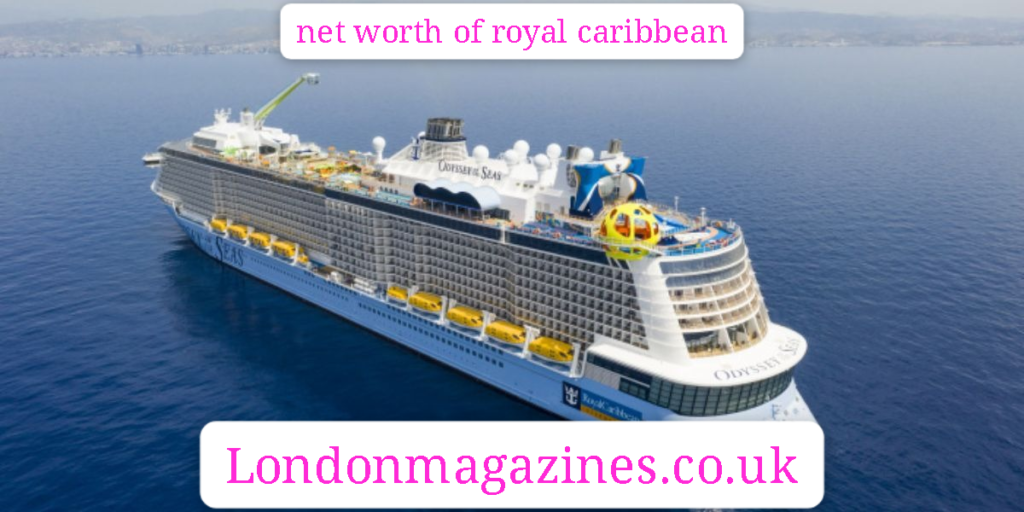Introduction
net worth of royal caribbean International is one of the largest and most successful cruise lines in the world, a company that has established a significant presence in the maritime industry. With a history that spans decades, it has grown from a small cruise line into a global juggernaut with a reputation for innovation, luxury, and adventure. But when it comes to understanding the company’s overall success and its financial standing, one key question arises: What is the net worth of Royal Caribbean?
The answer to this question isn’t simple, as a cruise line’s value isn’t just about its revenue or profits; it involves a complex combination of assets, investments, market position, and growth potential. In the case of Royal Caribbean, factors like its fleet of state-of-the-art ships, its presence in key global markets, its ability to maintain a competitive edge through technological innovations, and the strategic decisions made by its leadership have all played crucial roles in the company’s valuation.
In this article, we will take a deep dive into the net worth of Royal Caribbean, exploring the key elements that contribute to its financial standing. We will look at its revenue sources, fleet composition, financial performance, industry standing, and future outlook. Along the way, we’ll also touch upon the challenges faced by the company, including the impacts of global economic conditions and crises like the COVID-19 pandemic. This will give you a thorough understanding of not just how much Royal Caribbean is worth, but how it arrived at that valuation and what its future holds.
The Origins of Royal Caribbean and Its Rise in the Cruise Industry
net worth of royal caribbean was founded in 1968 in Norway by a group of Norwegian shipping entrepreneurs who saw an opportunity to revolutionize the cruise industry. The company was initially named Royal Caribbean Cruise Line, and its goal was to offer something different from the traditional cruise experiences that were available at the time. While many cruise lines focused primarily on leisurely ocean travel, Royal Caribbean aimed to bring luxury, excitement, and innovation to the cruising experience.
The company’s first ship, the Song of Norway, set sail in 1970 and was a breakthrough in terms of design and amenities. It featured modern facilities and a variety of onboard activities that set it apart from its competitors. As the years went on, Royal Caribbean expanded its fleet, adding ships that were not only larger but also more technologically advanced. In the 1980s, the company introduced the concept of the “megaship,” a larger, more luxurious vessel that could carry thousands of passengers and offer an unprecedented array of amenities. This innovation allowed Royal Caribbean to redefine the concept of cruising, setting it on a path of rapid expansion.
Over the years,net worth of royal caribbean continued to expand its fleet and service offerings. The company introduced a series of industry-first innovations, such as rock-climbing walls, ice skating rinks, and even surf simulators onboard its ships. These unique features made Royal Caribbean stand out in a competitive market and attracted a loyal customer base. The company also expanded its destinations, offering cruises to exotic and remote locations, and it built a series of private islands and ports of call for its guests.
As Royal Caribbean grew, so did its financial stature. The company began to report steadily increasing revenues, which were driven by both its expanding fleet and its growing reputation as a provider of cutting-edge cruise experiences. Over time, it became clear that Royal Caribbean was not just another cruise line but a global leader in the industry.
Royal Caribbean’s Financial Performance and Revenue Streams
As of 2024, net worth of royal caribbean financial performance reflects its status as one of the top players in the global cruise industry. The company generates revenue from a variety of sources, including ticket sales, onboard spending, and its private islands. Royal Caribbean’s diverse revenue streams have allowed it to weather various economic challenges and continue to grow over time.
One of the primary revenue sources for Royal Caribbean is its cruise ticket sales. The company offers a wide range of cruise options, from short getaways to extended voyages, and its prices vary based on the length of the cruise, the type of cabin, and the amenities offered. With its large fleet of ships, the company is able to accommodate thousands of passengers on each voyage, which helps to generate substantial income from ticket sales alone.
In addition to ticket sales, Royal Caribbean earns significant revenue from onboard spending. Passengers spend money on a variety of services, including dining, entertainment, excursions, and shopping. The company’s ships feature a range of restaurants, bars, and boutiques, as well as high-end spas and fitness centers, all of which contribute to its bottom line. Onboard spending has become an increasingly important revenue stream for Royal Caribbean in recent years, particularly as the company has introduced more luxurious and exclusive experiences for its passengers.
Royal Caribbean also earns money through its private islands and exclusive port of call destinations. The company owns a number of private islands in the Caribbean, including Perfect Day at CocoCay, which has been designed as a world-class destination for Royal Caribbean guests. These islands are a significant source of income for the company, as passengers pay for access to the island’s amenities, excursions, and activities.
In recent years, Royal Caribbean has also made significant investments in its digital infrastructure, offering guests the ability to book cruises online, manage their itineraries, and access a variety of virtual services during their trips. This shift toward digitalization has helped the company tap into new revenue streams, as well as enhance the overall guest experience.
The Role of Royal Caribbean’s Fleet in Its Valuation
One of the most important factors contributing to net worth of royal caribbean is its fleet of ships. The company operates one of the largest and most modern fleets in the world, with vessels ranging in size from the intimate Vision-class ships to the massive Oasis-class ships, which are among the largest cruise ships ever built. The size, design, and amenities of these ships are a major part of what makes Royal Caribbean such a successful cruise line.
As of 2024, Royal Caribbean’s fleet consists of more than 20 ships, all of which are equipped with the latest in technology and luxury amenities. These ships are valued in the billions of dollars, and their value plays a major role in the company’s overall net worth. The largest and most advanced ships in the fleet, such as the Symphony of the Seas and Oasis of the Seas, are worth more than $1 billion each. These ships not only represent a significant investment in terms of construction and maintenance costs but also contribute to the company’s revenue generation capabilities.
The value of Royal Caribbean’s fleet is also influenced by the company’s ongoing investments in new ships and upgrades to existing vessels. The company is constantly seeking to innovate and improve the guest experience, and this includes investing in cutting-edge technologies, sustainable practices, and more luxurious amenities. The fleet’s impressive size and technological advancements give Royal Caribbean a competitive edge in the market, helping to boost its valuation.
The Impact of the COVID-19 Pandemic on Royal Caribbean’s Net Worth
Like many businesses, net worth of royal caribbean faced significant challenges during the COVID-19 pandemic, which led to a temporary halt in cruising operations. The company was forced to suspend its cruises for several months, resulting in a sharp decline in revenue. The cruise industry as a whole was heavily impacted, with ships unable to operate, leading to financial losses for many companies in the sector.
However, Royal Caribbean was able to weather the storm by taking several steps to manage its financial position. The company secured additional funding through loans and capital raises to ensure it could stay afloat during the downtime. It also implemented new health and safety protocols to help reassure passengers and allow cruises to resume safely once restrictions were lifted. These efforts paid off, and as the global economy began to recover, Royal Caribbean was able to rebound quickly.
Despite the challenges, the pandemic ultimately highlighted the resilience of Royal Caribbean and its ability to adapt to difficult circumstances. The company has since experienced a recovery in demand, with bookings reaching pre-pandemic levels. This rebound has contributed to a strong recovery in its financial performance and has positively impacted its overall net worth.
The Future of Royal Caribbean: Growth Potential and Market Trends
Looking ahead, net worth of royal caribbean future appears promising, with the company continuing to invest in new ships, destinations, and experiences. The company’s growth strategy is focused on maintaining its position as a leader in the cruise industry by diversifying its offerings and appealing to new customer segments.
One of the key areas of focus for Royal Caribbean is sustainability. The company is investing heavily in environmentally friendly technologies, including energy-efficient ships and systems that reduce emissions. Royal Caribbean has made significant strides in adopting more sustainable practices, and this is likely to enhance its reputation and appeal to eco-conscious travelers.
Additionally, Royal Caribbean is exploring new markets, particularly in Asia and other emerging regions where the demand for cruises is expected to grow. By expanding its presence in these areas, the company hopes to capture a larger share of the global cruise market and further increase its revenue.
Conclusion
In conclusion, the net worth ofnet worth of royal caribbean is a reflection of its success as a leading cruise line, its ability to innovate, and its commitment to providing high-quality experiences for its passengers. The company’s financial performance is bolstered by its diverse revenue streams, its impressive fleet of ships, and its ability to adapt to challenges like the COVID-19 pandemic.
As of 2024, Royal Caribbean’s net worth stands at a significant value, driven by its strong market position, ongoing investments, and future growth potential. The company’s fleet of modern ships, its expansion into new markets, and its focus on sustainability all contribute to its continued success and its ability to thrive in a competitive industry.
FAQs
- What is Royal Caribbean’s net worth?
- As of 2024, Royal Caribbean’s net worth is estimated to be several billion dollars, primarily driven by its fleet of ships, its diverse revenue streams, and its strong market position in the global cruise industry.
- How many ships does Royal Caribbean operate?
- Royal Caribbean operates more than 20 ships, ranging from smaller vessels to massive megaships, such as the Oasis-class ships.
- How did the COVID-19 pandemic impact Royal Caribbean’s financials?
- The pandemic led to a temporary halt in operations, resulting in financial losses. However, the company took steps to secure funding and implement safety protocols, leading to a successful recovery.
- What are the key factors that contribute to Royal Caribbean’s net worth?
- Key factors include its large and modern fleet, diverse revenue streams (ticket sales, onboard spending, private island revenue), and ongoing investments in technology and sustainability.
- What is the future outlook for Royal Caribbean?
- The future looks promising, with the company focusing on sustainability, expanding into new markets, and continuing to innovate in order to maintain its leadership in the cruise industry.
Also Read This: The Net Worth of Royal Caribbean: A Deep Dive into the Success of a Global Cruise Giant


